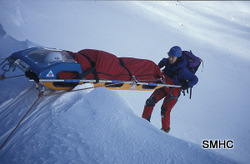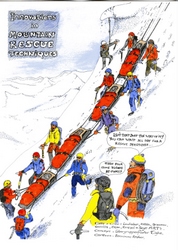
The Scottish Mountain Heritage Collection
Objects Database
The 'Katie' Stretcher
Accession Number
038.2008.1
Object Name
The 'Katie' Stretcher
Created
29/03/2008
Creator
Mick Tighe
Accession Date
29/03/2008
Brief Description
Prototype Mountain Rescue Stretcher. Glass Fibre body, aluminium poles, with detachable handles (4) triangular "CSCS" stickers on all parts. Blue internally and orange externally.
Materials
Glass Fibre and aluminium with perspex head guard protector.
Dimensions
217cm (L) x 64cm (W) x 14cm (H). Head Guard Height 40cm
Number Of Objects
1
Inscription Description
Triangular "CSCS" Stickers and miscellaneous direction stickers on all parts.
Colour
Blue internally, Orange externally
Maker
Jamie Keen
Provenance
"The Katie Stretcher
The Katie Stretcher project came about as the result of a bequest to the Mountain Rescue Committee of Scotland (MRC of S), which was given on the condition that it was used to improve mountain safety, and that it should carry the name of the benefactor's daughter, Catherine Smith, who had tragically died of altitude sickness in the Himalayas whist on honeymoon there," writes Jamie Kean, Kintail MRT.
"The MRC of S formed a Stretcher Development Group which I was invited to be a member of following developments that I had been working on in snow anchors as a member of Kintail MRT. The development process has resulted in the production of stretcher prototypes which have been displayed at both Scottish and UK MR conferences, and tested with a variety of Scottish MR teams.
The titanium Katie prototype is now very nearly 100% complete. The typical assembly time is 80 seconds. The carbon fibre/Kevlar composite shell design raises the casualty off the ground by over 50mm and also provides a modified W profile which makes it good for sledging down snow or grass slopes.
The underside of the shell has replaceable nylon rubbing strips which reduce abrasion on the shell itself. The shell's form plus the foam insulation in the base also provide buoyancy for river crossings and transfers to lifeboats. The foam insulation has a cushioning effect which enhances casualty comfort as well as keeping the cold out.
The wheel unit has suspension which is very effective and remarkably comfortable, using a trailer type unit. The wheel is a low cost, but durable wheelbarrow wheel, which is small enough for a spare to be carried in a rucksack if required.
The Barrowboy handles arc retractable from within the side tubes of the perimeter frame. They incorporate knuckle guards which rotate inwards when not in use thus keeping the stretcher's size as small as possible without unnecessary protrusions.
The three piece loadbed stacks compactly for storage and transit, and is designed to be carried in a large rucksack, similar to those made by Aiguille for vacuum mattresses. Once the stretcher is delivered to the incident site the rucksack can be used to carry the casualty's own sack if necessary.
Storage solutions
The loadbed gives space beside the casualty's legs for gas bottles to be stored. The bottles can be strapped down securely, and the standard hoses and masks are long enough to reach the head end. Positioning the bottles at the foot end also helps balance the loaded stretcher.
The positioning of the apertures for lift points gives provision for a six point lifting strop system. The frame, headguard and barrowboy handles are securely held together when assembled by 'snapper pins'. These pins are very quick and easy to use, and are very strong. The shell is assembled with draw latches and a security pin is provided to ensure that they can't inadvertently come undone.
Acquisition Method
Donated by Jamie Kean
Acquisition Date
29/03/2008
Condition Check Date
28/04/2009
Rules
Spectrum : UK Museum documentation standard, V.3.1 2007
Modified
28/04/2009


